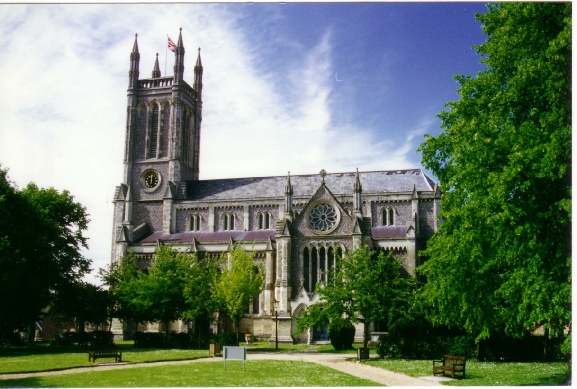



The Parish Church of St George the Martyr, Waterlooville

Easter Edition 2011
Country Churches
128. St Mary’s, Andover
The church today, with its tall imposing tower, is largely Victorian. The old Norman church was demolished in 1844. The new church was gifted to the town by Dr William S Goddard, a former Headmaster of Winchester College, who was living in retirement in Andover. He felt the old church was no longer appropriate.
The church was rebuilt in the Early English style of Salisbury Cathedral, and eventually cost £25,000, more than double the original estimate. It was dedicated on August 11 1844 though the tower was only completed two years later. Dr Goddard died, aged 88, in October 1845 and his remains were interred in front of the High Altar. In 1850 two stained glass windows were installed to commemorate Dr Goddard and his wife. One on the north side of the chancel shows the Baptism of Christ and the Risen Christ appearing to four soldiers, whilst on the south side the second window shows the Ascension and the raising of Lazarus.
The spacious interior of the church is of cruciform shape with two transepts. There are numerous lancet windows filled with Victorian glass. In 1950 a Memorial Chapel was constructed in the north transept. There on display is a Book of Remembrance and also a memorial to the men of New Street killed in the First World War. On the wall hangs a portrait of Dr Goddard as well as a list of all Vicars and Priors of St Mary’s back to 1304. The main window in the chapel depicts St Cecilia, the patron saint of musicians robed in green with a red toga. The lower portion shows her kneeling before her executioner. At the entrance to the chapel hang British Legion and Royal Naval Association standards.
Near the entrance to the south transept is a fine window showing St George defeating the dragon. It was placed there in memory of Clive Rose who was killed in a car accident in Andover. A plaque underneath commemorates his father, Horace Arthur Rose, who died in 1937 after many years of service in the Punjab where he did much to encourage women’s rights and better race relations.
Some memorials have been retained from the Norman church. The finest on the end wall of the south aisle is a 17th century memorial to Richard Venables and his wife Dorothy. He was a prosperous merchant in Andover. Dressed in black both are kneeling at prayer before a lectern. The family crest and coat of arms are shown overhead.
Other old memorials can be seen near the west door. The most interesting relates to Henry Hulton who died in 1791. He was appointed as First Commissioner of Customs in America in 1773 and his efforts to enforce the Tea Act that year resulted in the Boston Tea Party and the beginnings of the American Rebellion. Another tablet commemorates Richard Hillman who fought in the ensuing war as Lt Col of the 22 Regiment of Foot.
In the south west corner of the church is a striking new millennium window depicting the beauty of God’s creation. Designed by Mel House and inspired by Susan Ingram, it illustrates the River and Tree of Life as described in Revelations 22. On the left the Holy Cross ascends to Heaven through the boughs of a tree and on the right the Holy Spirit in the form of a dove descends from Heaven. There is also the old crypt which contains gravestones dating from around 1677 of the Pollen and Kingsmill families.
Outside on the south side there is a large grassy area which is overlooked by the impressive Andover War Memorial. This is the town’s Garden of Remembrance. Over 100 names are inscribed on four panels whilst the 62 names from the Second World War are carved on six tablets affixed to the low wall alongside. Unusually the main memorial is dated 1914-
John Symonds
